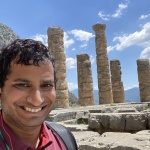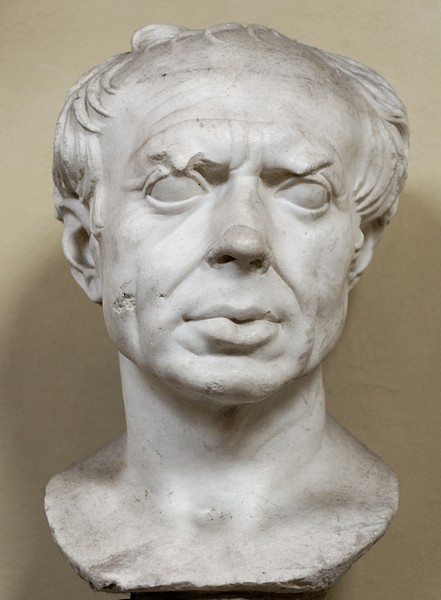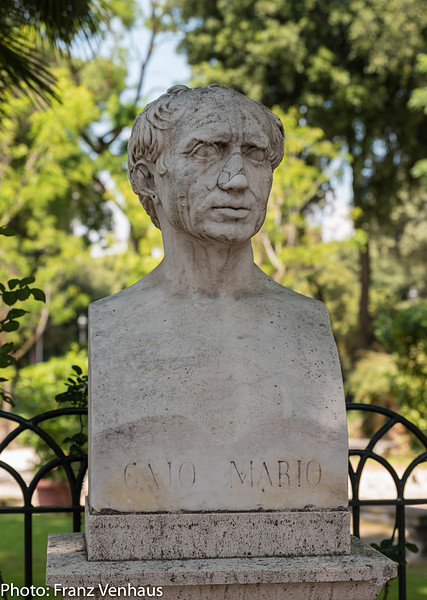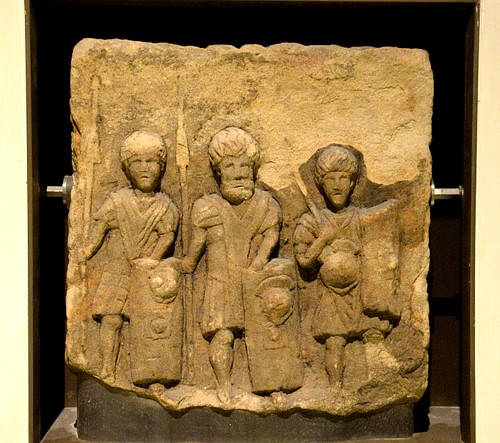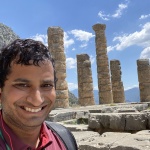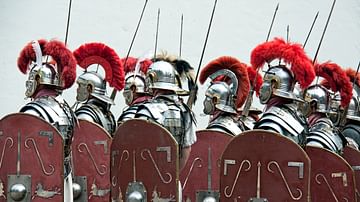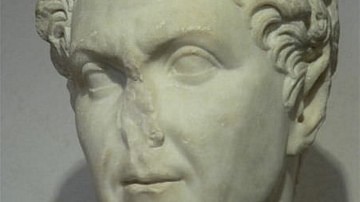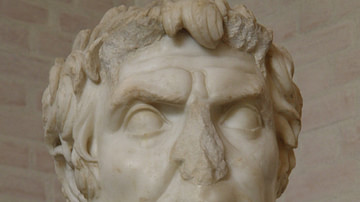The Marian Reforms were a set of the reforms introduced to the Roman army in the late 2nd century BCE by Roman general and politician Gaius Marius (157-86 BCE). Through these reforms, the Roman army was transformed from a semi-professional militia to a professional fighting force. The maniple system of the earlier Polybian legion was abolished and replaced with the cohort. The property qualifications for military service had also been severed. According to historian Adrian Goldsworthy in his book In the Name of Rome, by the end of the 1st century BCE, Roman politics, society, and the army had profoundly changed. "Marius' career, and the disorder of his times, was a symptom of these changes" (128).
Marius' reforms can be summarized into the following points:
- Inclusion of the common people known as the capite censi
- Replacement of the maniple with the cohort
- Inclusion of Marius' mules
- The eagle standard becomes the symbol of the legion
Polybian Legion
In order to understand the Marian army, one must consider the military structure of pre-Marian times. The troops were selected by a process called dilectus or "an elaborate ceremony of lot drawing and selection to allocate officers and soldiers to four consular legions which were raised each year from the tribes" of the Roman population (Matthew, 1). The early Roman legions consisted of roughly 4,000 infantry and 300 cavalry. They were divided into maniples, organized into a checkerboard formation, with ten maniples in each horizontal line. The term legion meant 'levy' and referred all the Roman people under arms, but by the 4th century BCE, it became the most important part of the army. At this time, the legion consisted of soldiers who owned enough property to afford their own equipment. The wealthiest men formed the cavalry, known as the equites while the poorest constituted the light infantry or the velites.
According to Polybius, the legion was divided into three rows according to experience. In the infantry, the first row of soldiers consisted of young men in their early twenties and poor citizens, who owned enough to make them eligible for military service. These were known as the hastati. The second row consisted of men in their twenties and thirties, who were known as the principes. The final row consisted of the elder veterans, armed with long spears. These men were known as the triarii. Each line had been divided into ten maniples and each maniple divided into two centuries commanded by a centurion.
Polybius stated their method of fighting was different from the Macedonians. Each legionary occupied spaces of three feet wide, away from those in front, behind, and in the same row as them. This allowed them to fight individually. The Roman soldier would defend his body with a long shield and use his sword for thrusting and cutting. This means each soldier had to fight two men in the front of the phalanx and fight against ten spear points. In this formation, the rear troops cannot support the front like in the phalanx. In battle, the skirmishers begin, throwing javelins in the hopes of breaking the enemy formation. Once the enemy was sent forward, the skirmishers retreated and the hastati were sent forward to fight. The principes would be sent forward if the hastati began to fail. "The triarii knelt on one knee with their left leg forward" (Polybius, 511). The triarii had their shields covering their left arm and their spears pointed up obliquely forward similarly to a palisade according to Livy. The triarii were only sent forward when all else failed, thus they served as a last resort.
Adrian Goldsworthy stated that only in method of winning in a forthright mass engagement against an enemy did the legion differ from a Greek hoplite phalanx or a Macedonian phalanx combined with its shock cavalry. They desired a quick, decisive clash, and they performed very well. When Hannibal, the famous Carthaginian general of the Second Punic War, engaged the Romans in battle, the legions took severe blows, but it was the same type of Roman army that defeated him with higher morale and better leadership.
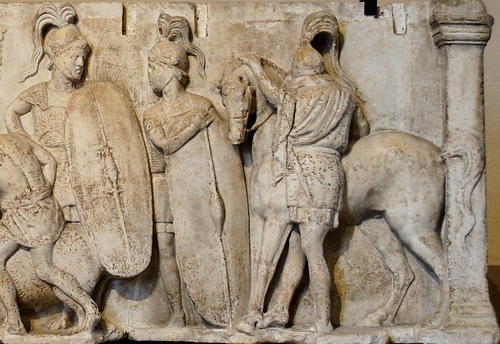
Marius
Plutarch claimed that Marius' parents were farmers growing up in the village of Ceraetae outside of Arpinium. It should be noted that only equestrians could seek election to any important magistracy at Rome and membership in this order required very considerable property. Members of the senatorial families began as equestrians until political success encouraged the "censors to enroll them in the Senate, but these formed a small minority of the Order, most of whom chose not to enter politics" (In the Name of Rome, 129). Marius' family was part of the aristocracy of Apinum with considerable influence in town. His military career started in 134 BCE when he served as a cavalry trooper under Scipio Amelianus in Spain. He "held a tribunate in the 120s BC and saw service in Asia Minor" (Matthew, 5). Marius was elected praetor in 115 BCE and afterwards was given a propraetorian governorship in Spain the following year.
In 111 BCE, Rome was at war with Jugurtha, the King of Numidia (a region consisting of parts of modern-day Algeria and Tunisia). In the following two years, the conflict raged on and there was no end in sight. Quintus Caecilius Metellus was placed in command by 109 BC along with Marius who became his cavalry commander. The following year Metellus was given an extended command, however, after battling at Muthul, Zama and Vaga, he failed to capture Jugurtha and end the war. With the support of the comitia or popular assembly, Marius replaced Metellus as commander, in control of the Numidian campaign. It was at this time that Marius would next initiate a set of reforms that would change the Roman army forever.
The Post-Marian Army
By Marius' time, the link between military service and property was severed. The capite censi or "head count" consisted of those who possessed little property and did not qualify for military service. Now they could enlist in the Roman army. As Plutarch stated regarding Marius:
He was triumphantly elected and at once began to raise troops. Contrary to law and custom he enrolled in his army poor men with no property qualifications, a class of people who used not to be accepted by commanders in the past, who gave arms, like other honours, only to those in the right income groups – the idea being that the possession of property guaranteed a man's loyalty to the state. (20-21)
When Marius took a group of these volunteers to Numidia, from a military standpoint, this allowed him to take fortifications and towns in the region and simultaneously pursue King Jugurtha. This army of volunteers, as opposed to drafted soldiers, resulted in a more effective fighting force and the riches of Numidia became loot.
Under Marius, the mobility of each soldier improved. Each legionary now carried his own baggage. With each soldier carrying his own supplies thus increased mobility and reduced the size of Roman baggage trains. They were now able to move more quickly and be more responsive.
Frontinus writes in his Strategemata:
For the purpose of limiting the number of pack animals….Caius Marius had his soldiers fasten their utensils and food up in bundles and hang these forked poles, to make the burden easy and to facilitate the rest, whence the expression Marius' mules.
Plutarch further adds:
After he had set out for the front he gave his army an intensive course of training while on the route. There was practice in running and long marches; and every man was compelled to carry his own baggage and to prepare his own meals. This was the origin of the expression 'one of Marius' mules.' (25)
Soldiers were now offered equipment, armor and clothing by the state. Recruits could enlist for a period of 16 years. All legionaries had the pilum, a spear introduced by Marius. Plutarch states that before the war with the Cimbri:
Marius first altered the construction of the javelin. Before this time, the shaft was fastened into the iron head by two nails of iron; now Marius, leaving one of these nails as it was, removed the other and put it in the place of a weak wooden pin, the idea being that on impact with the enemy's shield the wooden pin would break and, instead of the javelin sticking straight out, the shaft would twist sideways and trail down, though still firmly fixed to the iron head. (37)
They were also armed with a gladius, a short stabbing sword, instead of being provided specific weapons by experience. This made them equal in combat. They were organized into centuries each consisting of over 80 men. Each legion also had a single eagle as its standard. As Pliny the Elder recorded in his Natural History:
Originally the legions had the eagle, wolf, Minotaur, horse and boar as their badges, which went before the respective columns. Subsequently, eagles alone began to be carried into battle, while the other emblems were left in camp. Marius, in his second consulship, dispensed with the other emblems, and assigned the eagle to the legions as their special badge. From that time it was observed that there were scarcely ever a legionary winter camp without a pair of eagles in the immediate vicinity. (143)
The reforms of Gaius Marius abolished the maniple system and replaced it with a single cohesive unit known as the cohort. A single cohort consisted of three maniples, one from each of the lines of the older manipular legions. In this major reform to the Roman army, ten men formed a contubernium. Ten contubernia constituted a century and six centuries made up a cohort. The cohort offered several advantages. It showed a unit working together, and the men were no longer divided by experience.
Multiple cohorts proved to be a sufficient detachment if a force was "required for an operation not sufficiently large to warrant the use of an entire legion" (The Complete Roman Army, 46-47). This was easier for a commander because he would command ten cohorts as opposed to thirty maniples. He could send messages through the ten cohort commanders instead of thirty subordinates. Generally, the larger ten-cohort legion was used for large-scale warfare; the Romans could also deploy smaller forces than a legion to deal with smaller battles.
Furthermore, cohorts could be moved as individual units and were not permitted to move with the rest of the line. This made them more flexible strategically and tactically than the manipular legions. These soldiers were also more skilled with sieges than the older legions. During Julius Caesar's (l. 100-44 BCE) time these soldiers could make bridges to cross the Rhine, repair and construct ships, build siege towers and ramps, and fortification to blockade, which he did at the battle of Alesia in 52 BCE. Marius' reforms were an important transition from a militia to a professional army.
Marius' Mules
The major logistical transformation to the Roman army was the size of the baggage train that accompanied the legion on campaign and the amount of equipment a legionary carried. The troops carried "an array of equipment including rations, entrenching equipment and cookware on a forked pole carried over their shoulder as well as bearing their arms and armour" (Matthew, 39). The legions all shared a common ordeal by carrying the same equipment. As Christopher Matthew states in his thesis on the Marian reforms "the self-portage of equipment both increased the basic level of physical fitness of the legionaries and created a legion that was faster and more mobile by removing its dependence on cumbersome baggage trains" (Matthew, 90). This practice continued on into the early Roman Empire.
Military Consequences
When Marius included the larger, poorer masses into the Roman army, it was unlikely he was driven by a wish to overturn the traditional recruitment method; he did so out of necessity for further manpower. This reform allowed Rome to use greater reserves of manpower in comparison to when the property qualification was still in effect. Although recruitment from the lower classes was initially an emergency measure in the Roman Republic, it had many more advantages. When this proved to be effective, returning to the property qualification requirement was difficult.
There has been much discussion on what this meant for the soldiers themselves. One question that arose from this reform was if this made the solider more loyal to his commanding officer. A recruited soldier had little choice if he was called to fight for his country, but his greater desire was for plunder, booty, and survival. The soldiers who fought overseas did so in the hopes of obtaining a palpable reward from it. Marius also changed the Roman army from a citizen militia to a more proficient standing army. This resulted from a commander spending more time with his soldiers, thus forming closer bonds.
It is clear that for many of the landless poor a career in the army was an attractive proposition, but only so far as it provided some reward, which meant land. In many ways, this had been the basis of the amateur citizen soldier. (Sampson, 184-185)
Political Consequences & Legacy
Following the Jugurthine War, Marius had organized colonies in North Africa and did so again following the Northern Wars against the Germanic raiders. From a strategic view, the Roman policy of securing Italy to their control was exported overseas. However, previous colonial settlements were organized by the Roman Senate in conjunction with the assemblies and tribunes. During Marius' sixth consulship, the African colonies passed without incident. The foundation of the colonies for veterans was considered sound for social and strategic reasons and did not bring him into a clash with the Senate. One key social reason was that this relieved tension among the landless citizens of Rome.
Marius had created a professional army for the Roman state. Despite our paucity of sources, the Marian reforms show that Roman manpower had drastically increased with the abolition of the property qualifications for military service. Marius had men working together as a unit regardless of their levels of experience. They were offered new and better equipment, which increased their mobility and decreased the burden of baggage trains. Rome's armies were no longer a militia army and now became a professional fighting force.
